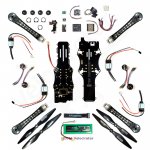Hey all, it is time for another multirotor build. I have been planning this one for the past few months. My first multirotor was a home built 600mm AP rig with a large gimbal for a pocket size camera. It flew, but pretty poorly and the footage was never really any good. So last winter I designed a new frame and gimbal, and got a simple, but promising flight controller. I managed to get good footage at times, but the flying was still poor and unsatisfactory. So now I coming back for round three and diving in with all new components. Third time's a charm right?
This build centers around the TBS Discovery frame. I decided to actually buy a frame instead of make one because I am tired of the inconsistencies and fragility that a DIY frame brings. The Disco seems like the best frame for AP/FPV purposes using GoPro sized cameras. I will also be upgrading from a two axis gimbal to a three axis gimbal. The Disco was made for a two axis gimbal, but I have seen some beautiful modifications to fit a three axis on board. I will also be ditching my previous multiwii based flight controllers for the Pixfalcon flight controller, as I have seen some incredible stability come from Pixhawk based platforms. I have down the calculations on ecalc and picked the components so this build has the greatest flight time possible: Full Parts List:
Copter:
Frame Body - TBS Discovery Link
Frame Arms - DJI Style Arms Link
Flight Controller - Pixfalcon Autopilot with M8N GPS Link
Motors - Sunnysky 2212 980kv Link
ESCs - Rotorgeeks 30a BLHeli Link
Battery - Multistar 5200mAh 4S Lipo Link
Props - Quanum 10x3.8 DJI Style CF Prop Link
Receiver - FrSky X8R Link
Voltage Regulation - Mini Step-Down Regulator Link
Gimbal:
Gimbal Controller - Storm32 Micro 3-Axis Gimbal Controller Link
Gimbal Frame - Custom Homebuilt/3D Printed
MISC - Rubber Tube Supports Link
MISC - Tarot 10mm 3K Carbon Tubes Link
I am looking forward to sharing this build with you all and hearing your thoughts and feedback!
-Sam
This build centers around the TBS Discovery frame. I decided to actually buy a frame instead of make one because I am tired of the inconsistencies and fragility that a DIY frame brings. The Disco seems like the best frame for AP/FPV purposes using GoPro sized cameras. I will also be upgrading from a two axis gimbal to a three axis gimbal. The Disco was made for a two axis gimbal, but I have seen some beautiful modifications to fit a three axis on board. I will also be ditching my previous multiwii based flight controllers for the Pixfalcon flight controller, as I have seen some incredible stability come from Pixhawk based platforms. I have down the calculations on ecalc and picked the components so this build has the greatest flight time possible: Full Parts List:
Copter:
Frame Body - TBS Discovery Link
Frame Arms - DJI Style Arms Link
Flight Controller - Pixfalcon Autopilot with M8N GPS Link
Motors - Sunnysky 2212 980kv Link
ESCs - Rotorgeeks 30a BLHeli Link
Battery - Multistar 5200mAh 4S Lipo Link
Props - Quanum 10x3.8 DJI Style CF Prop Link
Receiver - FrSky X8R Link
Voltage Regulation - Mini Step-Down Regulator Link
Gimbal:
Gimbal Controller - Storm32 Micro 3-Axis Gimbal Controller Link
Gimbal Frame - Custom Homebuilt/3D Printed
MISC - Rubber Tube Supports Link
MISC - Tarot 10mm 3K Carbon Tubes Link
-Sam
















